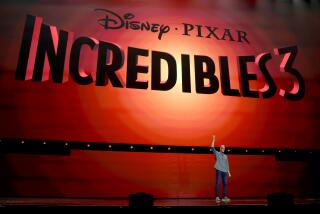COMPUTER GRAPHICS SHOW : STATE OF HIGH TECH, NOT STATE OF ART
For anyone interested in computer animation, the international film and video show at the annual SIGGRAPH (Special Interest Group for Computer Graphics) conference is the equivalent of the network fall premieres: Scientists and artists unveil their newest work amid considerable hoopla.
This year’s show, which debuted Tuesday night and ended Thursday at the Anaheim Convention Center, appeared to represent the state of the technology, rather than the state of the art.
A nightly two-hour program showcased glitzy images from commercials, television logos and rock videos, as well as technical innovations, but the artistic content of most of the films was miminal at best. Only a few computer animators seem to understand how to use the basic elements of timing, staging, editing and motion to entertain an audience or present an idea effectively.
John Lasseter, the creator of the Oscar-nominated “Luxo, Jr.,” continues to expand the emotional range of computer-generated characters in “Red’s Dream” (USA). In a deserted bike shop, Red, a unicycle, fantasizes about a glamorous career as a circus star. When Red slumps forlornly against the shop wall, the audience feels a genuine sympathy for the lonely little machine. Credible emotions are rare in contemporary animation, and “Red’s Dream” ranks as an impressive achievement, despite some weak gags in the circus fantasy.
The only rival to “Red’s Dream” in entertainment value was “Oilspot and Lipstick” (USA), which marked the Walt Disney studio’s belated debut in computer character animation. Two junkyard dogs composed of spare parts battle a monster steam shovel in a comic adventure that recaptures the high-spirited fun of the classic studio cartoons. Although some of the movements were obviously borrowed from “Lady and the Tramp” and “Fantasia,” director Mike Cedeno and his talented crew display considerable promise in a field too often devoid of humor.
In the educational division, Jim Blinn explained difficult concepts like the physics of light and the Heisenberg Uncertainty Principle with remarkable clarity in “The Quantum Mechanical Universe” (USA), slated for broadcast on PBS. Moving equations, two- and three-dimensional images deftly blend with an unpretentious narration to illustrate ideas impossible to visualize in any other medium.
The elegant, austere patterns of “Victory Sausage” (USA) by computer graphics pioneer John Whitney Sr., eclipsed the other entries in the Music Visualization and Fine Art categories.
Most of the show was devoted to show reels from various commercial studios. A 20-second chrome-and-neon network logo may provide a striking break in prime-time programming, but watching dozens of them together quickly cloys.
It’s depressing to realize that in barely two decades of widespread use, computer animation has already fallen into so many cliches: a glittering corporate name or symbol that turns in space, as the camera circles it; plastic peacocks that zoom in and out of infinity; silvery car engines that churn to homogenized disco sound tracks. Recognizable, individual studio styles are virtually nonexistent.
These high-tech visuals are increasingly at odds with the loose, organic style of contemporary graphics. The rare attempts to incorporate funky new-wave figures into computer films look effortful and unsatisfying.
The films in the SIGGRAPH show contained the flashiest images being put on film today, but there aren’t enough ideas to support all the razzle-dazzle. These shorts suggest that some of the most advanced technology around is being wasted on visual cotton candy, instead of providing genuinely exciting, moving or challenging entertainment.






